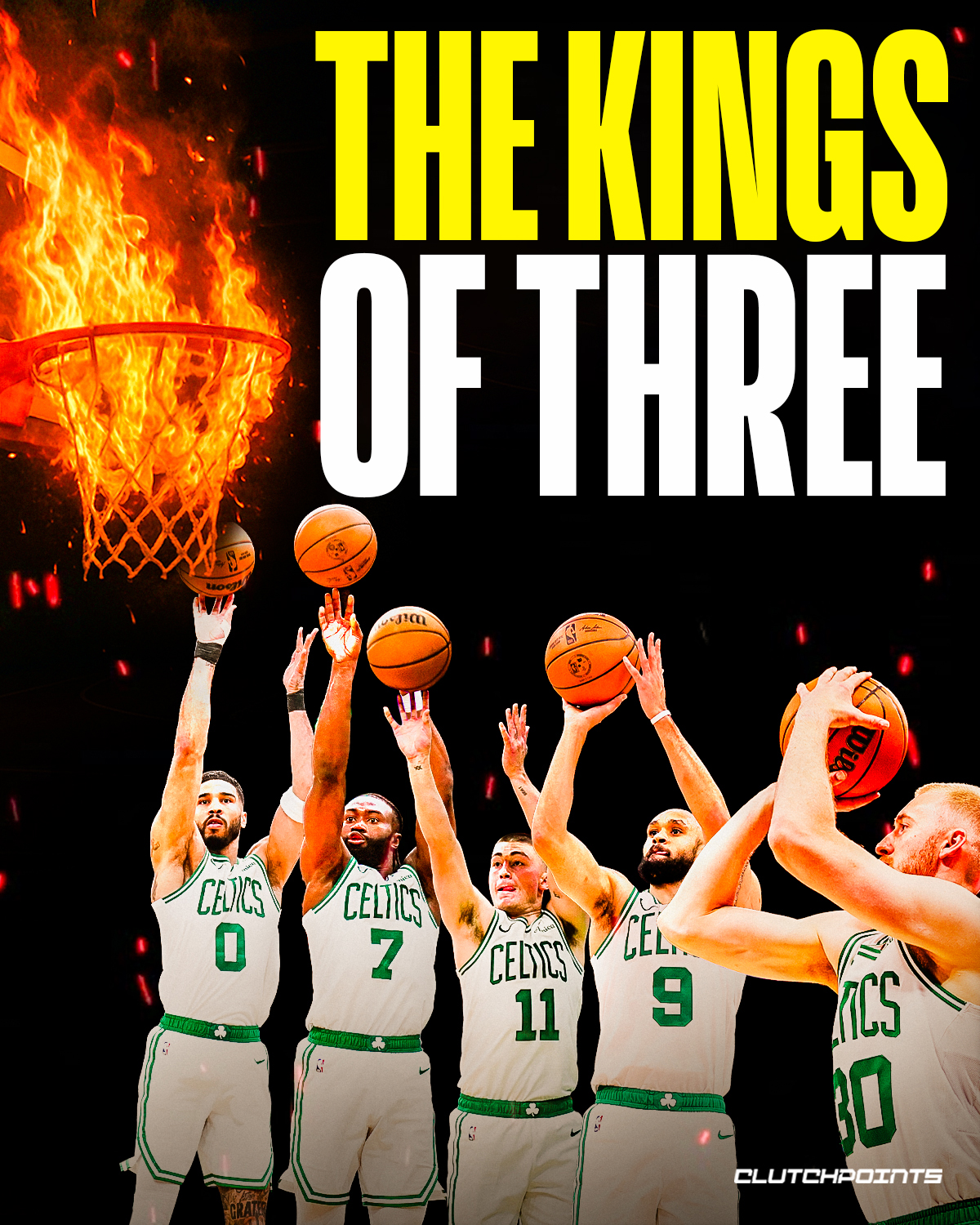The Boston Celtics unleashed an unprecedented barrage from beyond the arc last season, completely rewriting the NBA’s record books. What unfolded over the course of the season wasn’t merely a statistical anomaly or a short-lived hot streak—it was a strategic shift that fundamentally altered the way basketball is played and perceived, even in a league that has seen a radical three-point evolution over the past decade. The Celtics’ three-point renaissance wasn’t just about quantity but also about precision, spacing, chemistry, and an unwavering commitment to a game plan that emphasized long-range shooting as the heartbeat of their offense.
Throughout the 2024–25 NBA season, the Celtics embarked on a campaign that showcased not only their talent but their collective buy-in to a modern offensive philosophy. Led by head coach Joe Mazzulla, who leaned heavily into analytics and the value of the three-point shot, the team entered the season with a clear identity. They weren’t going to simply “take” threes—they were going to *hunt* them. They were going to create advantages through ball movement, spacing, and elite decision-making, all aimed at generating clean looks from distance. This wasn’t a team chucking up desperation heaves in isolation; it was a machine, carefully calibrated, synchronized, and devastatingly effective.
The numbers tell only part of the story, but they are staggering nonetheless. The Celtics shattered the NBA record for most three-pointers made in a season, eclipsing the previous mark with games to spare. They ended the regular season with a staggering 1,476 made threes, averaging over 18 per game. To put that in perspective, the league-average team just a decade earlier made roughly eight to nine per contest. Boston more than doubled that figure, redefining what was previously thought possible from deep. But the shooting wasn’t just high volume—it was efficient. They shot over 39 percent from beyond the arc as a team, a number that would be impressive for a single sharpshooter, let alone an entire roster.
Jayson Tatum and Jaylen Brown, the Celtics’ All-Star duo, both expanded their games to fit seamlessly into this long-range revolution. Tatum in particular made a conscious effort to improve his shot selection and release speed, adding side-step threes, pull-ups off the dribble, and deeper range to his already versatile offensive arsenal. His ability to score at all three levels made him nearly impossible to guard, but it was his three-point shooting that most consistently bent defenses out of shape. Brown, always a physically dominant wing, improved his footwork and catch-and-shoot mechanics, allowing him to become a lethal off-ball threat when Tatum or others collapsed the defense.
But perhaps the most critical component of the Celtics’ perimeter assault was their depth. Unlike some teams that rely heavily on one or two elite shooters, Boston had an entire roster stocked with long-range snipers. Derrick White emerged as one of the most underrated shooters in the league, hitting over 40 percent of his attempts from deep. His ability to play both on and off the ball gave Boston immense flexibility in its guard rotations. Malcolm Brogdon, though coming off the bench, provided a steady hand and consistent perimeter shooting that punished second units. Sam Hauser, often flying under the radar, became a fan favorite and analytics darling, stretching the floor with relentless precision.
The acquisition of Kristaps Porziņģis proved to be a masterstroke in the Celtics’ offensive evolution. His ability to stretch the floor as a seven-footer created unprecedented spacing. Defenders were faced with an impossible choice—leave Porziņģis open beyond the arc and risk a clean look from one of the league’s best shooting bigs, or stay home and allow driving lanes for Boston’s wings. His presence often pulled opposing rim protectors away from the basket, clearing the paint for cuts, drives, and kick-outs. When combined with Al Horford—who continued to defy age with consistent outside shooting—the Celtics could deploy a frontcourt that not only protected the rim but also bombarded opponents from deep.
This system, as effective as it was during the regular season, translated seamlessly into playoff basketball. Traditionally, long-range shooting is expected to regress slightly under postseason pressure, when defenses tighten, scouting is more detailed, and legs grow weary. But Boston’s system proved resilient. Their threes didn’t come from broken plays or desperate isolation; they were the result of precise execution and disciplined reads. The team’s commitment to ball movement ensured that the extra pass was always made, often turning a decent shot into a great one. That commitment to the process—rather than the results—was what sustained them through multiple grueling playoff series.
Defensively, their shooting created as much of an advantage as any scheme. With opponents constantly playing catch-up, Boston often forced teams out of their comfort zones. The sheer volume of made threes gave them more transition opportunities, tilted the possession game in their favor, and often deflated opposing teams who struggled to match their scoring pace. While defense wins championships, in this case, it was a historically explosive offense that paved the way for postseason dominance.
The ripple effects of Boston’s record-breaking season are likely to be felt across the NBA for years to come. Other teams will undoubtedly study the Celtics’ blueprint, analyzing not just the numbers but the culture and discipline that made it sustainable. The Celtics didn’t merely jack up threes because it was trendy; they built a system designed to support it. The emphasis on spacing, the personnel decisions, the practice reps, the accountability—all were critical in ensuring the volume was matched by efficiency. This wasn’t just a stylistic choice; it was a strategic foundation.
One cannot overlook the role of coaching and front office vision in this transformation. Mazzulla, despite facing criticism early in his tenure for his reliance on the three-point shot, remained steadfast in his belief. He adjusted when necessary, particularly on the defensive end, but he never wavered from his core offensive principles. Brad Stevens, overseeing the roster from the front office, constructed a lineup uniquely suited for this modern approach. Every addition—whether via draft, trade, or free agency—was evaluated through the lens of shooting, decision-making, and fit within a system that prioritized offensive fluidity and versatility.
The Celtics’ shooting identity also had intangible benefits. It fostered a sense of unselfishness and camaraderie. Players knew that the system worked best when everyone was involved, when the ball moved side to side, and when spacing was respected. There was a palpable sense of trust—trust that making the right read would lead to the right shot, even if it wasn’t your shot. That kind of cohesion isn’t built overnight; it’s the result of shared goals, countless hours of repetition, and leadership both on and off the court.
Even the TD Garden atmosphere seemed to reflect the team’s transformation. There was an electricity in the air every time the ball found its way to the corner, every time Tatum pulled up from 30 feet, or when Hauser stepped into a rhythm three off a pin-down screen. Fans didn’t merely cheer for made baskets—they anticipated them. The Celtics had turned the long ball into a theatrical event, one where the outcome often felt inevitable. It was entertainment, yes, but it was also a statement: this is how modern basketball can look when executed to perfection.
What makes Boston’s three-point onslaught all the more remarkable is that it didn’t come at the expense of traditional basketball virtues. They rebounded well, played elite defense, communicated, and closed out games with maturity. Their three-point barrage wasn’t a gimmick or a fad—it was the tip of a much larger iceberg, supported by fundamentals and professionalism. It was showtime with substance, flash with grit.
As the league looks ahead, it’s clear that Boston’s 2024–25 campaign will serve as both a blueprint and a benchmark. Future teams will be compared to this iteration of the Celtics not just in terms of three-point records, but in how they built a system around it, how they empowered players to thrive within it, and how they sustained excellence over 82 games and deep into June. The Celtics didn’t just shoot their way into the record books—they changed the expectations for what an elite offense can look like in the modern NBA.
In retrospect, this Celtics season may be remembered as a turning point. Not because it marked the beginning of the three-point era—that began years ago—but because it may have signaled the beginning of its perfection. Where others dabbled, Boston committed. Where others relied on stars, Boston empowered a roster. Where others sought quick fixes, Boston built from the ground up. The Celtics didn’t just embrace the three; they mastered it. And in doing so, they not only rewrote the record books—they redefined what was possible.



